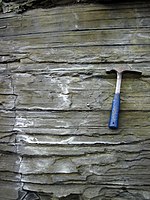
Photo from wikipedia
Abstract Marcellus Shale was investigated as a storage reservoir for CO2, applying CO2 as an enhanced hydrocarbon recovery agent, and examining the CO2 alteration of the shale as a sealing… Click to show full abstract
Abstract Marcellus Shale was investigated as a storage reservoir for CO2, applying CO2 as an enhanced hydrocarbon recovery agent, and examining the CO2 alteration of the shale as a sealing unit. The investigation was comprised of observing the geochemical interaction of CO2 and water with two Marcellus Shale samples (MS-1 [silicate-rich] and MS-4 [carbonate-rich]) using various analytical techniques. In-situ Fourier Transform infrared (FT-IR) spectroscopy at geological storage conditions (high temperature and pressure) was used to examine the geochemical interaction of CO2 (with and without water) and Marcellus Shale. FT-IR results showed that CO2 interacted physically with the clay and kerogen components of dehydrated Marcellus Shale samples while dissolving in the water layer in the hydrated Marcellus Shale samples to promote carbonate dissolution. Feature relocation scanning electron microscopy was utilized to document the physical changes and the pore alterations based on exposure to CO2 with and without water. SEM indicated significant carbonate dissolution to the MS-4 sample after exposure to CO2 and water. Density function theory (DFT) and sorption isotherms were used for pore size analysis and to quantify CO2 sorption. The results were very different for the two Marcellus Shale samples studied. The MS-4 showed dissolution of carbonate to be a major reaction under hydrated conditions with a loss of mesopore volume from 68% to 40%, while MS-1 often showed an opposite trend. Both the MS-1 and MS-4 samples showed that significant volume of macropores larger than 200 nm were present. Isotherm results suggested uptake of CO2 of the MS-4 sample is four times greater than the MS-1 sample.
Journal Title: Fuel
Year Published: 2020
Link to full text (if available)
Share on Social Media: Sign Up to like & get
recommendations!